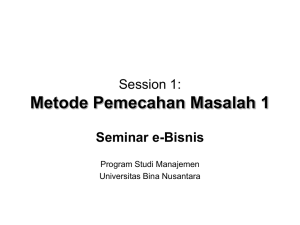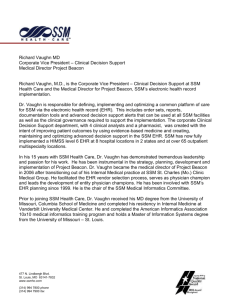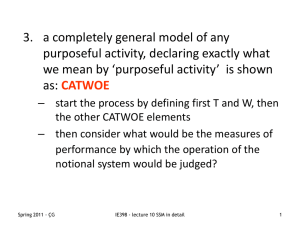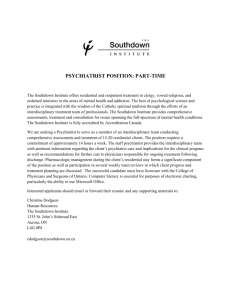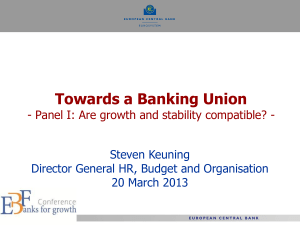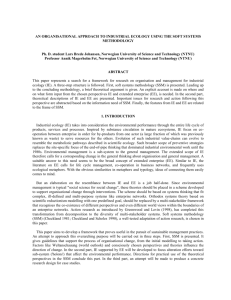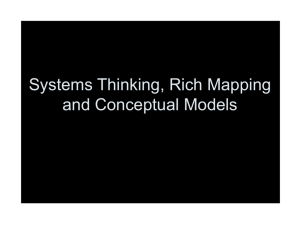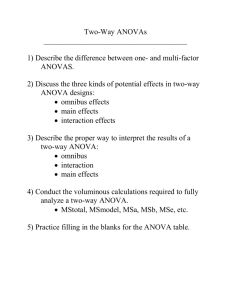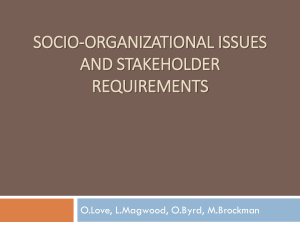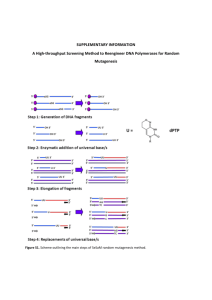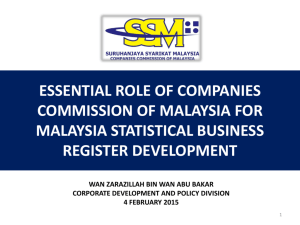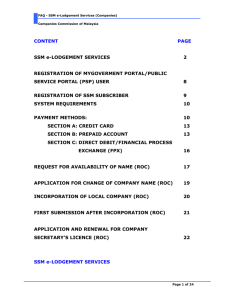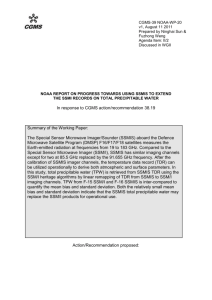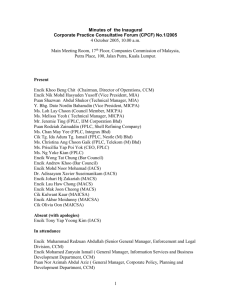Lecture 19
advertisement
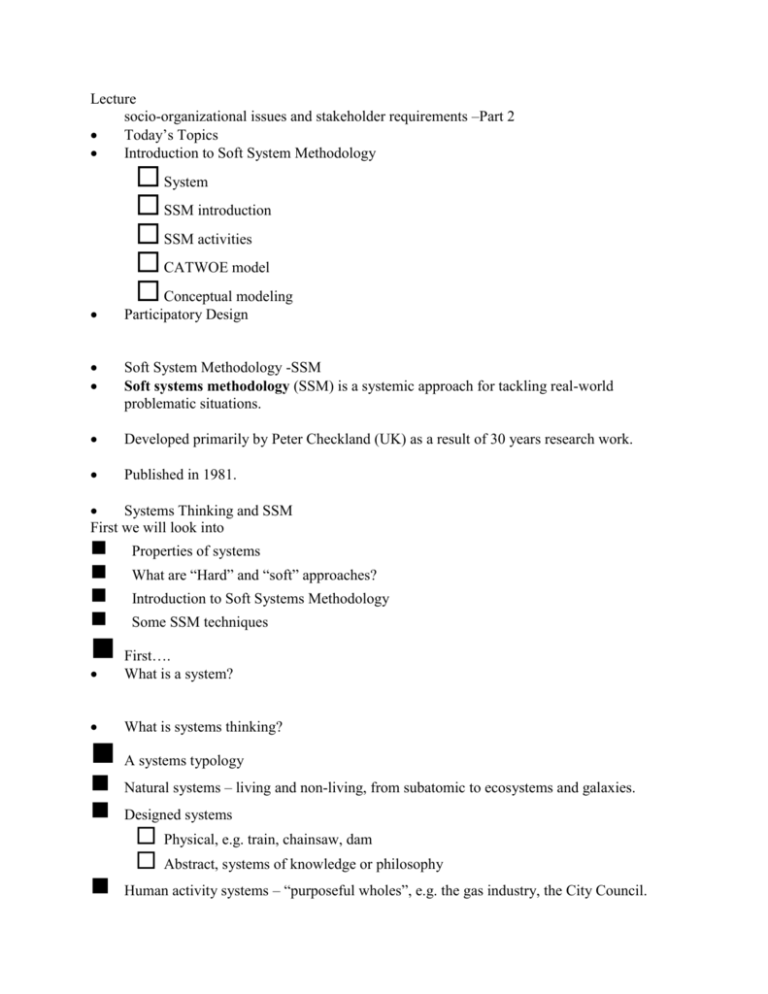
Lecture socio-organizational issues and stakeholder requirements –Part 2 Today’s Topics Introduction to Soft System Methodology System SSM introduction SSM activities CATWOE model Conceptual modeling Participatory Design Soft System Methodology -SSM Soft systems methodology (SSM) is a systemic approach for tackling real-world problematic situations. Developed primarily by Peter Checkland (UK) as a result of 30 years research work. Published in 1981. Systems Thinking and SSM First we will look into Properties of systems What are “Hard” and “soft” approaches? Introduction to Soft Systems Methodology Some SSM techniques First…. What is a system? What is systems thinking? A systems typology Natural systems – living and non-living, from subatomic to ecosystems and galaxies. Designed systems Physical, e.g. train, chainsaw, dam Abstract, systems of knowledge or philosophy Human activity systems – “purposeful wholes”, e.g. the gas industry, the City Council. Social systems – overlap natural and human activity systems, e.g. family. (Checkland, 1981) Socio-Technical Systems Systems ideas have been applied to organizational behaviour in many ways. For example, the concept of socio-technical systems sees organizational systems as having Technical subsystem – formal processes, tasks, machinery, programs, with official goals, etc. Social subsystem – human concerns & needs; personal goals, views & interests; communications, motivation, job satisfaction etc. Characteristics of Systems A boundary Hierarchy – parts which may themselves be systems Emergence Systems (and subsystems) have properties which their contituent parts do not possess Examples of emergent properties? Communication – parts can interact Control processes – to ensure continuity Control - Feedback Control - Feedforward Open & closed systems Open systems Interact with their environment through inputs and outputs that cross the system boundary Include organizational and living systems Closed systems Don’t interact with their environment. (Or, take in only energy, e.g. the biosphere or various mechanical gadgets.) These are best viewed as relative terms. Two well known phrases Reductionism. Simplification for analysis Computer people do this often! Holism Dividing into parts loses connectedness & emergent properties. “Hard” and “soft” problems Hard problems: Soft problems: Hard and soft systems thinking Structured, clear when a solution is found, Subject to reasoning, problems about “how”. Often in engineering, science. Dealing with blown fuse, designing a bridge, etc. Unstructured, messy, no clear solutions. Questions about “what” to do. Often in organisations, social situations, politics – situations involving people. “Hard” systems thinking treats parts of the world as systems, and investigates/ engineers them. Systems taken to exist. “Soft” systems thinking uses a process of enquiry which is systemic. This uses systems models to help find out about the real world, so we may explore the consequences of choosing to view elements as if they were systems, but the systems we model are notional, not representations of the world. (See Checkland, 1999) Experience teaches: “Hard” problems are susceptible to “hard” approaches “Soft” problems need “soft” approaches. What is SSM? A systemic process of learning For exploring problem situations in organisations For suggesting changes which will be helpful and achievable SSM - Basic Overview SSM Overview - activities Using SSM Not intended as a prescriptive set of steps. Start anywhere, finish anywhere, repeat ad lib. Adapt as necessary. Why SSM? Practical and flexible approach to managing change Holistic approach that takes a wide range of factors into account, inc. social and political aspects Aims to suggest change that is meaningful and feasible in the organisational context Can be highly participative Why SSM for IS? It’s NOT a complete development method. But has been extended with techniques for IS Useful for IS-related problem “solving.” Used in Feasibility Requirements capture IS Planning The aim is to have systems which are seen as relevant, fit the organisation, and are used. Example SSM IS projects Recording the activities of community health workers Decision support in a marketing company Providing mission briefings for fighter pilots Managing assignment submission for distance learners SSM Overview - activities Entering the problem situation “A situation in which there are perceived to be problems” Don’t concentrate on “the” problem We may enter the problem situation as external consultants, or work on our own problem situations. What to put in a rich picture Structure, e.g. departmental or organisation boundaries, geographical considerations, people and institutions. Process - activities, information or material flows. Climate - the relationship between structure and process, and any associated problems. ‘Soft facts’ - concerns, conflicts, views. Environment - external interested bodies, factors affecting the organisation. Commonly used symbols SSM Overview - activities Thinking about the problem situation What important tasks are taking place? What issues have you identified? Name “relevant systems” (of human activity) Relevant systems Relevant to exploring, debating and changing the problem situation Relevant from some “world view” - Weltanschauung More than one - choose a variety of views, ideas Phrase as “A system to ….” Relevant systems (2) Primary task systems deal with the main task of the organisation, from some viewpoint. Issue-based systems deal with issues, problems etc. Not always a clear-cut distinction, but aim to include both! SSM Overview - activities Root definition (1) Short definition of a relevant system Defines who would be involved, purpose, viewpoint from which it’s defined, “A system to….” We usually work with several definitions Root definition (2) “Who is doing what for whom, to whom are they answerable, what assumptions are being made, and in what environment.” (Checkland) However, we use the CATWOE terminology CATWOE Identify the W that makes them meaningful and the main transformation. Remember: NOT a description of what happens in the real world. Customers Actors beneficiaries/victims those who do T Transformation input output Weltanschauung world view, makes T meaningful Owner responsible (who could stop T?) Environment “givens”, constraints Building RD & using CATWOE Either: Write a root definition, Validate it using CATWOE as a checklist Define any missing elements Rewrite RD to include them Or: Define CATWOE Write a RD that includes all of them. Some leading practitioners criticise this approach. Root Definition Example A Department of Computing owned system by which academic staff define a unit syllabus in accordance with university standards for unit definition such that the unit will make the expected contribution to the route, provide clear learning objectives for students and be deliverable in practice within the constraints on staff time and other resources within the department. C CATWOE for unit planning example CStudents AAcademic staff T Route’s requirement for unit requirement met by unit syllabus meeting criteria stated (i.e. objectives, deliverable in practice) W Importance of clear definition of units to route planning and student learning; units should have a defined place within the route. O Department E University standards for unit definition, time and resource constraints Another RD example A system to provide regular checkups, advice and treatment to diabetic adults in the Southdown & Downsville area by means of outpatient appointments at Southdown General Hospital in order to empower them to control their diabetes. CATWOE for clinic RD A T W O E CATWOE from clinic RD C - diabetic adults in the Southdown & Downsville area A-? T - patients with current level of support --> patients with the necessary support, advice and treatment to enable them to manage their diabetes W - O/P care can provide support that will enable people to control their diabetes. Patients as responsible managers of their own treatment, not passive recipients O-? E - SGH, O/P clinic, Southdown & Downsville area Revised CATWOE for clinic RD Cdiabetic adults in the Southdown & Downsville area Amedical, nursing & admin staff of the clinic. Tpatients with current level of support --> patients with the necessary support, advice and treatment to enable them to manage their diabetes WO/P care can provide support that will enable people to control their diabetes. Patients as responsible actors in their own treatment, not passive recipients OSGH management ESGH, O/P clinic, Southdown & Downsville area, HA budget and staffing constraints. Revised clinic RD An SGH-management-owned system, staffed by medical, nursing and clerical staff of the hospital and operating within the Health Authority’s constraints on budget and staffing, to provide regular checkups, advice and treatment to diabetic adults in the Southdown & Downsville area by means of outpatient clinic visits at Southdown General Hospital, in order to ensure that all are empowered to control their diabetes. SSM Overview - activities Conceptual modelling Identify minimum necessary set of activities Define topics & time allocation Document unit to university standards Appreciate university standards for unit definition Appreciate unit’s expected contribution to route Define learning objectives Decide method of delivery Appreciate time & resource constraints Conceptual model The 3 (or 5) E’s Efficacy: does the means work, does it actually achieve the transformation? Efficiency: does it use the minimum necessary resources? Effectiveness: is the transformation meeting the longer term aim? Also Ethicality and Elegance. SSM Overview Participatory Design Users are actively involved in development Should be used if you want to draw on existing artifacts Not suited for radical design changes Participatory Design (Cont.) Data collection Observations, interviews, collaborative design and cooperative prototyping guided by a well-defined research question Data analysis Outcome Participatory Design (Cont.) Examples of paper based prototyping techniques for participatory design Analyze artifacts at breakdowns Analyze videos, interviews and prototypes collected from sessions with the users Working with the users, the product is evolved from the existing artifact Pictive Some design components are prepared by the developers Pen, pencil, sticky notes, paper etc. are used by the users Video recording devices are used to record what happens PICTIVE Participatory Design (Cont.) Card The same principle as Pictive but with screen dumps The cards are used to explore workflow options with the user Summary Soft systems methodology takes a broader view of human and organizational issues. Participatory Methodology Keeps users’ expectations in check Users’ thinking can be constrained to what they are used to Whenever users are available and willing to take part in the design
